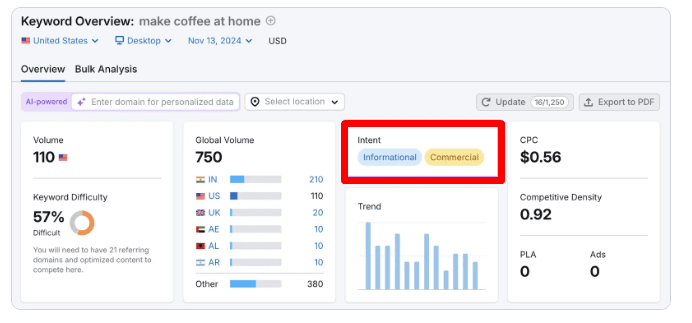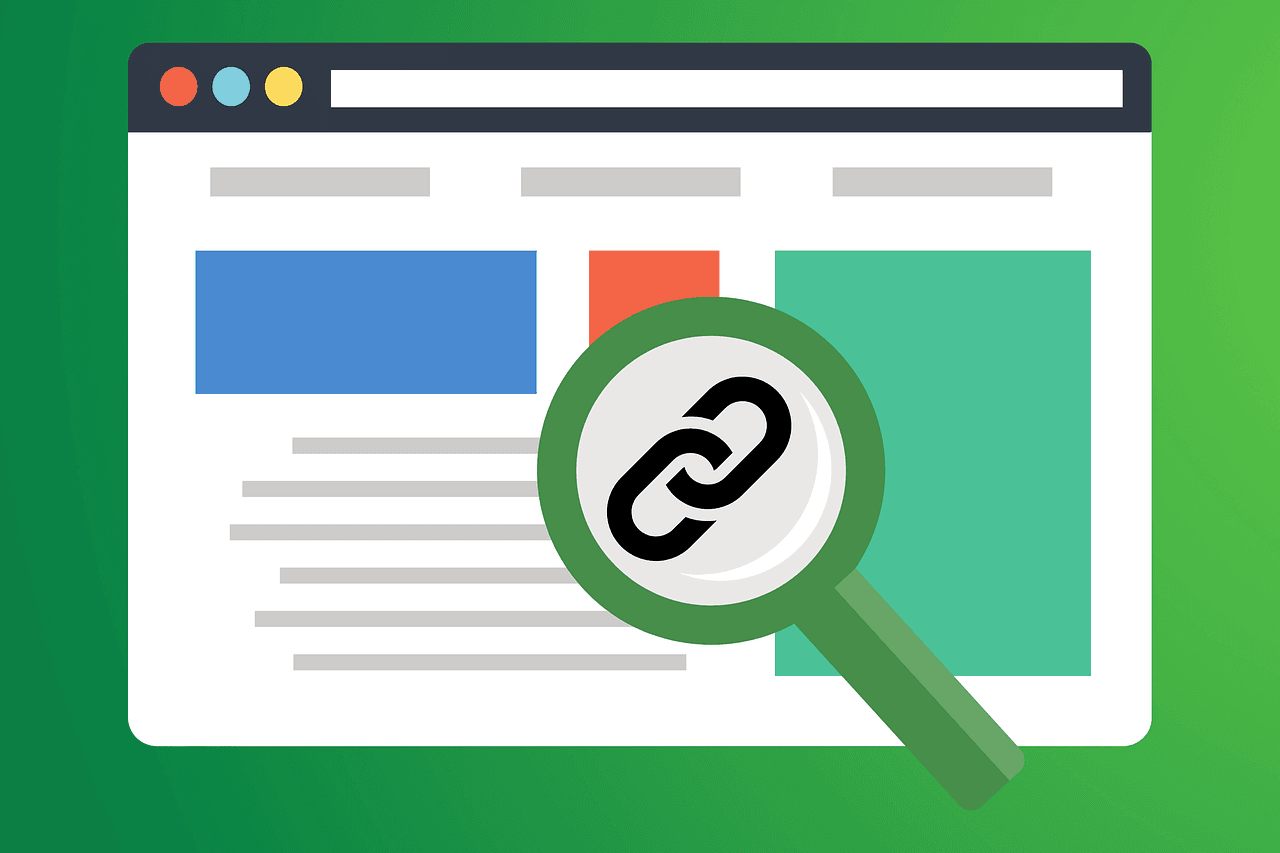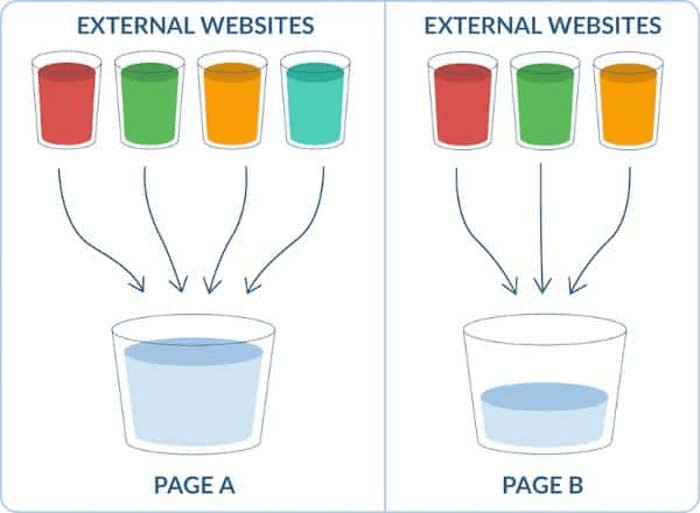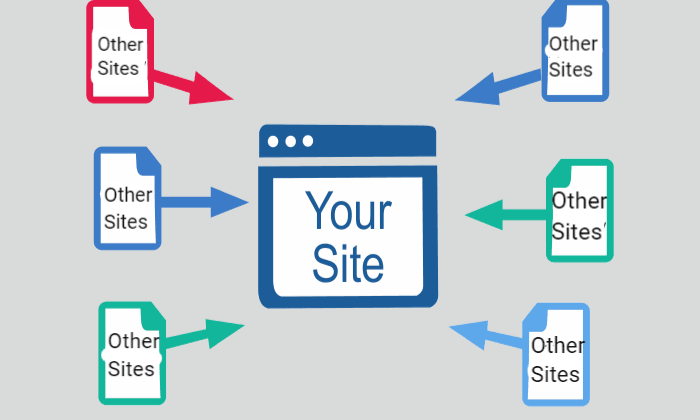SEO keyword intent is the reason behind a user’s search query, whether it's to gather information, make a purchase, or find a specific site. Understanding this concept is essential for improving SEO performance. At Keyword Metrics, we break down how intent shapes your strategy.
What is SEO Keyword Intent?
SEO keyword intent is a crucial concept in search engine optimization (SEO) that helps you understand the true purpose behind a user's search query. Essentially, it refers to the reason why someone searches for a particular keyword or phrase.
Understanding keyword intent is important for creating content that matches what users are looking for, which can ultimately improve your website's rankings and drive more relevant traffic.
How Keyword Intent Works in SEO
When someone enters a search query into Google (or any other search engine), they are looking for something specific. This “something” is the intent behind the keyword. SEO keyword intent helps you align your content with the user's needs by understanding the underlying goal of their search.
There are four main types of SEO keyword intent:
1. Navigational Intent
The user is searching for a specific website or brand. For example, if someone types “Nike official site,” they are likely trying to visit Nike’s website directly.
2. Informational Intent
The user is looking for information or answers to questions. Queries like “how to tie a tie” or “SEO basics” fall under this category. The goal is to provide content that answers these questions comprehensively.
3. Transactional Intent
The user is ready to make a purchase or take a specific action. Keywords like “buy running shoes online” or “best phone deals” indicate that the user is looking to make a transaction.
4. Commercial Intent
The user is researching products or services to make an informed decision but hasn’t made a purchase yet. A search for “best smartphones for photography” is an example of this intent, where the user is comparing options before buying.
Importance of Keyword Intent in SEO
When you align your content with the right intent, your chances of ranking higher in search engine results pages (SERPs) increase.
Here’s why SEO keyword intent matters:
Improved User Experience
By understanding what users want, you can create more relevant and useful content, enhancing their experience on your site. For example, if someone searches for “how to fix a leaky faucet,” providing a detailed step-by-step guide will satisfy their needs more than a product page on plumbing services.
Higher Conversion Rates
When you optimize your content for transactional or commercial investigation intents, you can increase your chances of converting visitors into customers. A well-targeted landing page with a clear call to action (CTA) will encourage users who are ready to buy to take the next step.
Better Search Engine Rankings
Google prioritizes content that satisfies user intent. If your page effectively addresses the intent behind a search query, it’s more likely to appear higher in the SERPs.
Focused Content Strategy
Understanding keyword intent helps you plan your content strategy. You’ll know which pages to create for informational queries and which ones to design for transactional queries.
Tools for Analyzing SEO Keyword Intent
To effectively identify and optimize for SEO keyword intent, using the right tools can make a huge difference.
Here are some essential tools that help you analyze search intent and guide your content strategy:
Google Keyword Planner
Google Keyword Planner is a free tool that helps you discover keyword ideas and analyze their search volume, competition, and trends. By looking at the search results for different keywords, you can gauge the type of intent behind them. For instance, if keywords like “buy shoes online” are associated with product pages, you can infer transactional intent.
Pro Tip: Use Keyword Planner to identify long-tail keywords (more specific phrases) that help refine your content to match user intent more accurately.
SEMrush
SEMrush is another excellent tool for keyword research and intent analysis. It provides detailed data on search volume, competition, and keyword variations. You can also view the top-ranking pages and analyze their content to determine the intent behind a keyword.
Pro Tip: SEMrush’s "Keyword Magic Tool" allows you to discover keywords with similar intent and helps you understand how to optimize your content for various types of searches.

Ahrefs
Ahrefs offers powerful keyword research features that help you uncover search volume, keyword difficulty, and intent. By analyzing the SERPs for a specific keyword, you can see whether users are looking for information, making a purchase, or visiting a specific website.
Pro Tip: Ahrefs’ SERP overview lets you filter results by intent, helping you understand what type of content Google favors for a given keyword.
Answer The Public
Answer The Public is a unique tool that generates keyword ideas based on real user questions. This is especially helpful for understanding informational intent, as it reveals what questions people are asking around a topic. It also shows the types of content that tend to rank for these queries.
Pro Tip: Use this tool to brainstorm blog posts or guides that directly answer common questions related to your target keywords, optimizing for informational intent.
Pro Tips for Using SEO Keyword Intent Effectively
To fully leverage SEO keyword intent in your strategy, consider these pro tips:
Research Keyword Intent
Use keyword research tools like Google Keyword Planner, Ahrefs, or SEMrush to analyze the search intent behind specific keywords. Look at the search results for a keyword and identify whether the pages ranking at the top are offering informational, transactional, or navigational content.
Create Content That Matches User Intent
Once you’ve identified the intent behind a keyword, make sure your content aligns with it. For example, if the search query indicates transactional intent, create product pages or service offerings that directly address the user's needs. For informational intent, consider blog posts, guides, or FAQs.
Use Clear Calls to Action (CTAs)
When targeting transactional intent, ensure your content includes clear, compelling calls to action that guide the user toward making a purchase or taking the next step.
Optimize for Different Types of Intent
Don’t focus on just one type of intent. A well-rounded SEO strategy targets a mix of informational, transactional, and commercial investigation intents. For example, you could create blog posts (informational), comparison pages (commercial investigation), and product pages (transactional).
Monitor Performance
After optimizing your content for keyword intent, monitor your rankings and conversion rates. If a page targeting a transactional keyword isn’t converting, try refining your content or adjusting the CTA to better align with user expectations.
How Keyword Intent Can Change Over Time
Keyword intent is not always fixed; it can evolve based on various factors such as user behavior, trends, and even changes in the market. Here’s how and why it happens:
Changes in User Behavior
As users’ needs and habits evolve, so does their search behavior. For example, a user who initially searches for “best laptops for gaming” might later refine their search to “buy gaming laptops under $1000.” In this case, the keyword intent shifts from informational (gathering information) to transactional (making a purchase).
Market Trends and Seasonal Changes
Certain keywords can change in intent depending on market trends or seasonal fluctuations. For instance, during the holiday season, keywords like “best Christmas gifts” or “Black Friday deals” often reflect transactional intent. However, after the season passes, these queries may focus more on informational intent (e.g., “how to wrap gifts” or “how to prepare for Black Friday”).
Search Engine Algorithm Updates
Search engines like Google frequently update their algorithms, which can influence the way search results are ranked. A change in the algorithm might cause a shift in user intent for certain keywords. For example, Google might begin showing more transactional results for queries that previously displayed informational content, or vice versa.
Changes in Industry or Product Offerings
The intent behind keywords can also change due to innovations or shifts within specific industries. For example, as new technology or products are introduced, users may transition from researching general information about a product to searching for specific purchase options.
Long-Tail Keywords and Intent Evolution
Long-tail keywords, which are longer and more specific search phrases, are often more sensitive to changes in user intent. Over time, as users become more familiar with a topic or product, their queries may evolve. What began as a broad search for "smartphone reviews" might change into a more specific search like “best smartphone for photography 2025,” reflecting a shift in intent from general research to focused decision-making.
FAQs about SEO Search Intent
Q: Why does keyword intent matter in SEO?
A: Understanding keyword intent helps ensure that your content is relevant to what users are searching for. This leads to better user engagement, higher rankings, and improved conversion rates.
Q: How do I identify keyword intent?
A: Keyword intent can be identified by analyzing search queries and the type of content that ranks for those keywords. Tools like Google Keyword Planner can also offer insights into search intent.
Q: Can I target multiple types of keyword intent on the same page?
A: It’s possible to target multiple intents within one piece of content, especially if the page serves different stages of the buyer’s journey. For example, an informational blog post could include links to transactional product pages.
Related Glossary Terms to Explore
- SEO Keyword Research: Learn how to perform keyword research to identify search intent.
- On-Page SEO: Discover how to optimize your website for better search rankings.


